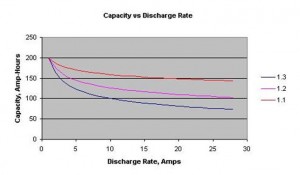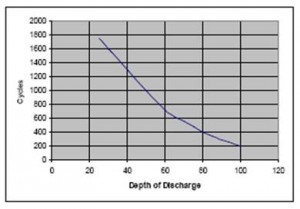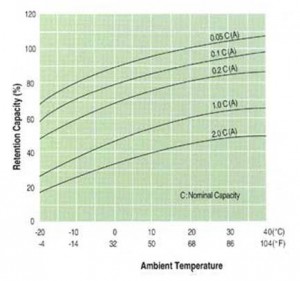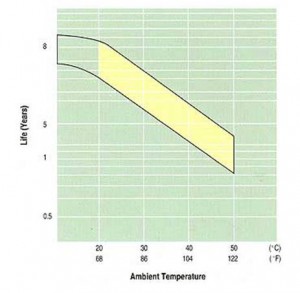BATTERIES PROPERTIES
Capacity. Direct current produced from power sources such as PV arrays, wind generators, hydraulic power generators or any other power transformation element can be stored in electric batteries. Capacity is the electrical energy storage potential, and it is customarily expressed in ampere-hours (Ah) although can be also expressed in watt-hours (Wh) by multiplying Ah by the battery Voltage. A battery capable of storing 350 Ah is theoretically able to supply 3.5 amperes for 100 hours or 35 amperes for 10 hours before the battery arrives to a complete state of discharge. However, storage capacity is not actually a fixed number but depends of many factors as for example: age, temperature, rate of discharge, and depth of discharge.
Battery voltage is usually standardized in multiples of 2 volts. The most common voltages are 6 and 12 volts although other voltages are also marketed. As with any other power source batteries need to be connected in series to increase voltage or in parallel to obtain usable current or amperage.
Rate of Discharge. As soon as a load is connected to a battery or to a battery system, the battery or battery system begins to convert chemical energy into electrical energy. Although a battery may be specified at certain volts, the working voltage is rather a range than a fixed number. This range may well be between 1 volt more or less over or below that number. For example a nominal 12 volts lead acid battery may be at 13 volts when fully charged and then get down to 11 during the discharge process. Manufacturers also usually specify a cut-off voltage below which no further usable capacity may be present in the battery.
Battery capacity depends on the rate of discharge which is defined as the ratio of the nominal battery capacity to the discharge time expressed in hours. For example, the denomination C/20 for a 350 Ah battery indicates that 350 Ah capacity are obtained when the battery is discharged in a 20 hour period. That is 1/20 of the nominal capacity or 17.5 amperes can be discharged per hour for a capacity of 350 Ah.
This same battery may produce 460 Ah if discharged in a 100 hours period; or what is the same: if the rate of discharge is reduced to 4.6 amperes per hour, the capacity increases to 460 Ah.
In general grater capacities are obtained for slower discharge rates.
Depth of Discharge. This term commonly referred to as DOD is the percentage of capacity that withdrawn from a battery. Batteries use in PV systems is specified for DODs from about 40 to 80 percent. The life of a battery normally increases as DOD decreases. Manufactures guarantees batteries in years but specifications are also given in number of cycles (of charge and discharge) for different DOD values. For example a battery specification may state 400 cycles at 80% DOD and/or 2000 cycles at 20% DOD. That is to say: battery life increases for slower depths of discharge.
State of Charge. This term normally referred to as SOC is the complement of DOD, both terms make 100%. Therefore, SOC is the percentage of energy stored in a battery after certain DOD has been withdrawn from the same battery.
Days of Autonomy. The period in days for which the battery system must support the load is referred to as DOA or days of autonomy. A compromise among load to be supported, storage capacity, depth of discharge, days of autonomy, and cost must be considered before deciding on battery system sizing and configuration. It might not be economical to provide full load storage capacity for regions with extensive periods of cloudiness so hybrid approaches utilizing wind power or a generator might lead to better solutions. Recommendations vary from 3 to 7 days or even more. Maps that indicate these periods for different regions have been published. Also there are statistics compiled about the average number of cloudy days in a year for different zones that may guide the decision about adoption of the DOA.
Temperature Effects. The rate of the electrochemical reactions that takes place in batteries are influenced by current as well as temperature. Battery capacity decreases and battery life increase at lower temperatures, battery capacity increases but battery life decrease at higher temperatures. For lead acid batteries the optimum capacity is obtained around 80 degrees Fahrenheit or about 27 degrees Centigrade. If operation temperature gets down to 32 degrees Fahrenheit or 0 grades Centigrade a battery may loose up to 35 % of its capacity. Temperature of 95 degrees Fahrenheit (35 ºC) could represent a 50 % battery life lost. Therefore, the batteries should be located where average temperatures resemble the manufacture recommended temperature. Battery manufacturers supply data in tabular or graphical form as to the capacity variation for operation temperatures others than optimum. This data as well as other characteristics is needed for battery selection. A typical example of battery capacity and life variation with temperature is of the following Figure.




Pingback: Introduction « BATTERIES FOR PHOTOVOLTAIC SYSTEMS